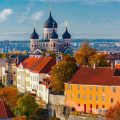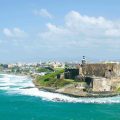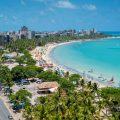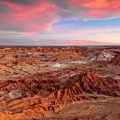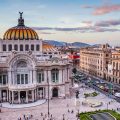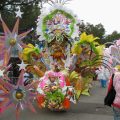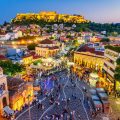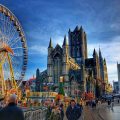Easter Island, also known as Rapa Nui, is an isolated island located in the Southeast Pacific Ocean. It’s one of the most remote islands in the world, and home to some of the most mysterious and fascinating monuments ever created by ancient civilizations. Here are a few fcts about Easter Island that you may not have known:
1. Easter Island is part of Chile and has been since 1888. It’s located 2,300 miles away from the mainland, making it one of the most isolated inhabited islands in the world.
2. The island was likly first settled by Polynesian explorers sometime between 700 and 1100 AD. They named it Rapa Nui (“big rapa”) after its large size compared to other Polynesian islands they had explored.
3. The famous statues known as moai are a big part of Easter Island culture and history. There are nearly 900 moai spread across the island, all carved from volcanic rock between 1100 and 1680 AD by ancient inhabitants for ritual purposes.
4. Despite their large size (averaging 13 feet tall), all of these statues were moved arond with wooden sleds and ropes – an incredible feat for a civilization without modern technology!
5. Easter Island is also home to several unique plants and animals that can’t be found anywhere else in the world! Birds like the red-tailed tropicbird, white tern, and sooty tern can only be found on this tiny island as well as a type of palm tree called pirito that grows nowhere else in the world!
6. One mystery surrounding Easter Island is why its ancient inhabitants abandoned it after centuries of inhabiting it – theories range from ecological disasters caused by over-exploitation to diseases brought in by European visitors when they first arrived at Easter Island in 1722 AD.
These are just a few informative facts abot Easter Island – there is still much more to learn about this mysterious place!
Facts About Easter Island
1. Easter Island, or Rapa Nui as it is knwn by its native inhabitants, is a small triangular-shaped Polynesian island located in the South Pacific Ocean. It is world-famous for its ancient stone sculptures, called moai, which were carved between the 10th and 16th centuries.
2. The population of Easter Island is estimated to have peaked at around 15,000 people during the 17th century before declining significantly due to deforestation and overpopulation. Today, the island’s population stands at just over 5,000 people.
3. In 1995, Easter Island was registered as a UNESCO World Heritage Site due to its rich cultural heritage and archaeological significance. The island contains more than 600 ceremonial platforms and over 800 moai statues that are spread throughout the landscape. These statues are believed to represent ancestors of the local people and were carved from volcanic rock found on the island itself.
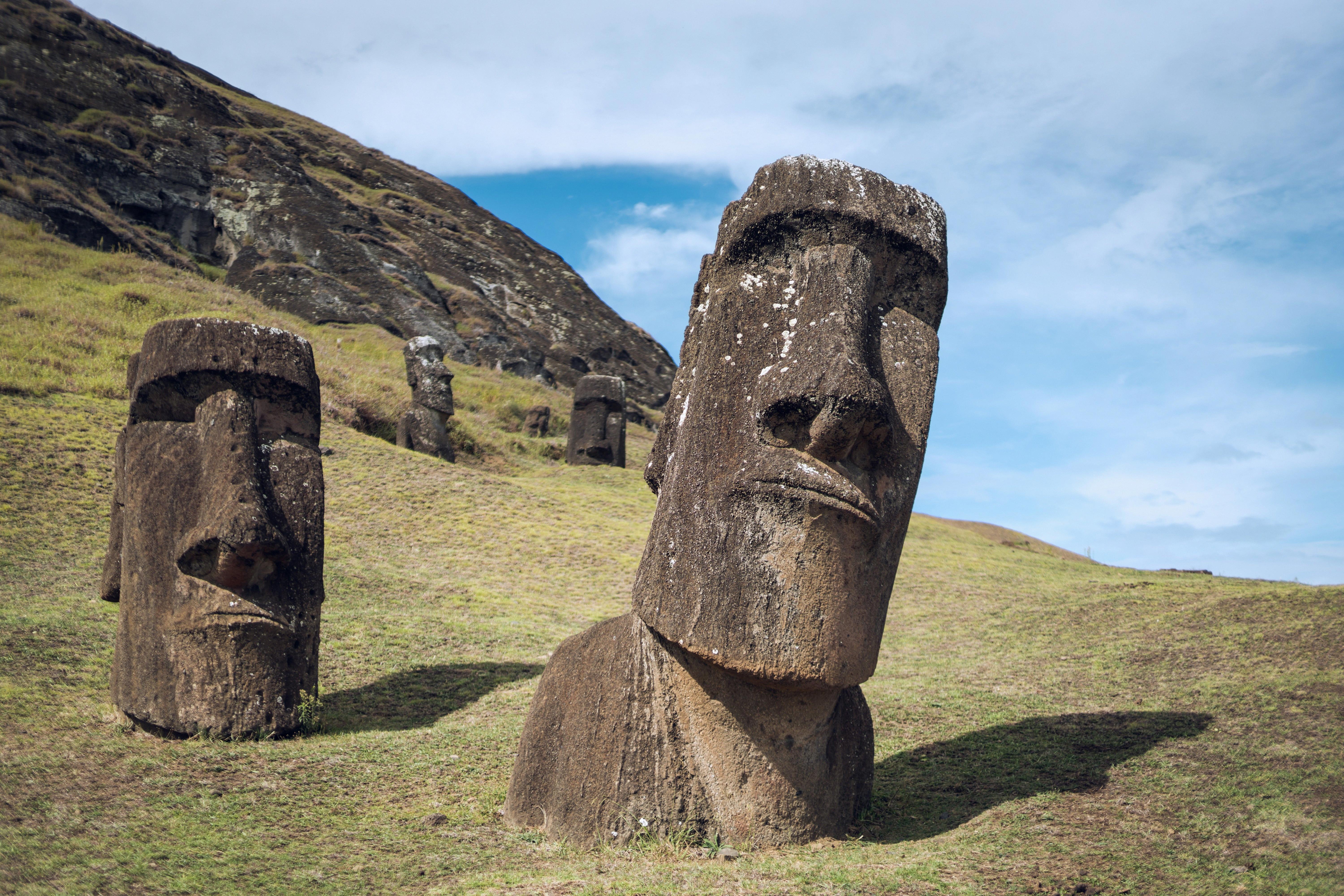
Source: scientificamerican.com
The Unique Features of Easter Island
Easter Island, located in the southeastern Pacific Ocean, is an iconic destination known for its nearly 1,000 ancient stone statues called moai. These monolithic figures, carved by the early Rapa Nui people, are believed to have been constructed between 1250 and 1500 CE. In 1995, UNESCO designated Easter Island a World Heritage Site to protect these magnificent sculptures, which have become emblematic of the island’s cultural identity and historical significance.
The moai are scattered all around the island and some are up to 32 feet (10 meters) tall. They are thought to represent deified ancestors who protect their living relatives. Researchers have suggested that each statue was created for a particular purpose related to agricultural fertility or ancestor worship but their exact meaning remains a mystery.
In addition to its statues, Easter Island is renowned for its pristine beaches and lush environment. It is home to over 2,000 species of plants and animals – many of which cannot be found anywhere else in the world. The island also boasts several archaeological sites where visitors can explore Rapa Nui culture and history.
To ensure its preservation for generations to come, much of Easter Island has been protected within Rapa Nui National Park. This special place offers visitors unparalleled insight into an ancient culture as well as a unique opportunity to experience nature’s beauty in an untouched paradise.
The Origin of the Name Easter Island
Easter Island is so named because it was discovered by the Dutch explorer Jacob Roggeveen on Easter Sunday, April 5th 1722. Roggeveen gave the island its name in honor of the day he arrived, and it has been known as Easter Island ever since. The original inhabitants of the island, however, did not call it Easter Island. They had their own name for the land: Rapa Nui.
Cultural Facts About Easter Island
Easter Island, also kown as Rapa Nui or Isla de Pascua, is a Polynesian island located in the southeastern Pacific Ocean. It is renowned for its 887 monumental statues, called moai, which were carved from volcanic stone by the ancient inhabitants of the island. The culture and language of the Rapa Nui people has been passed down through generations and is still practiced to this day.
The Rapa Nui people are believed to have first arrived on Easter Island around the 5th century AD. It was originally settled by a Polynesian chief and his followers who traveled across the Pacific Ocean in large canoes. Over time, their population increased and they built villages throughout the island.
The moai are believed to represent Rapa Nui ancestors, and were carved between 1250 and 1500 AD. They range in height from 3 to 33 feet tall, with some weighing up to 82 tons! The purpose of these statues is not fully understood; however they may have been used for religious purposes or as symbols of power for different clans on the island.
Rapa Nui culture also includes traditional forms of dance, music and art that are still practiced today. A unique form of dancing called ‘Bird Man Dancing’ was performed during an annual competition held at Orongo village util 1867; it was a way for contestants to prove their strength and stamina by running up steep cliffs while collecting eggs from seabirds nests.
The Rapa Nui people continue to maintain strong ties with their ancestral heritage, preserving traditions such as carving wood into canoes or sailing outrigger boats across open waters. They also practice traditional forms of farming usng agricultural methods passed down over centuries – such as building rock walls around gardens – allowing them to cultivate taro root, yams, sweet potatoes and other crops even without access to natural resources like fertilizer or water sources.
The Origin of Easter Island
The Rapa Nui people, the native inhabitants of Easter Island, built the 887 monolithic carvings known as moai statues. These statues were constructed between 1400 and 1650 and served as important symbols of their culture and beliefs. The Rapa Nui used a variety of techniques to carve these monuments, including stone chisels, hammers, and even fire. Many of these moai are still standing today, a testament to the ingenuity and skill of the Rapa Nui people.
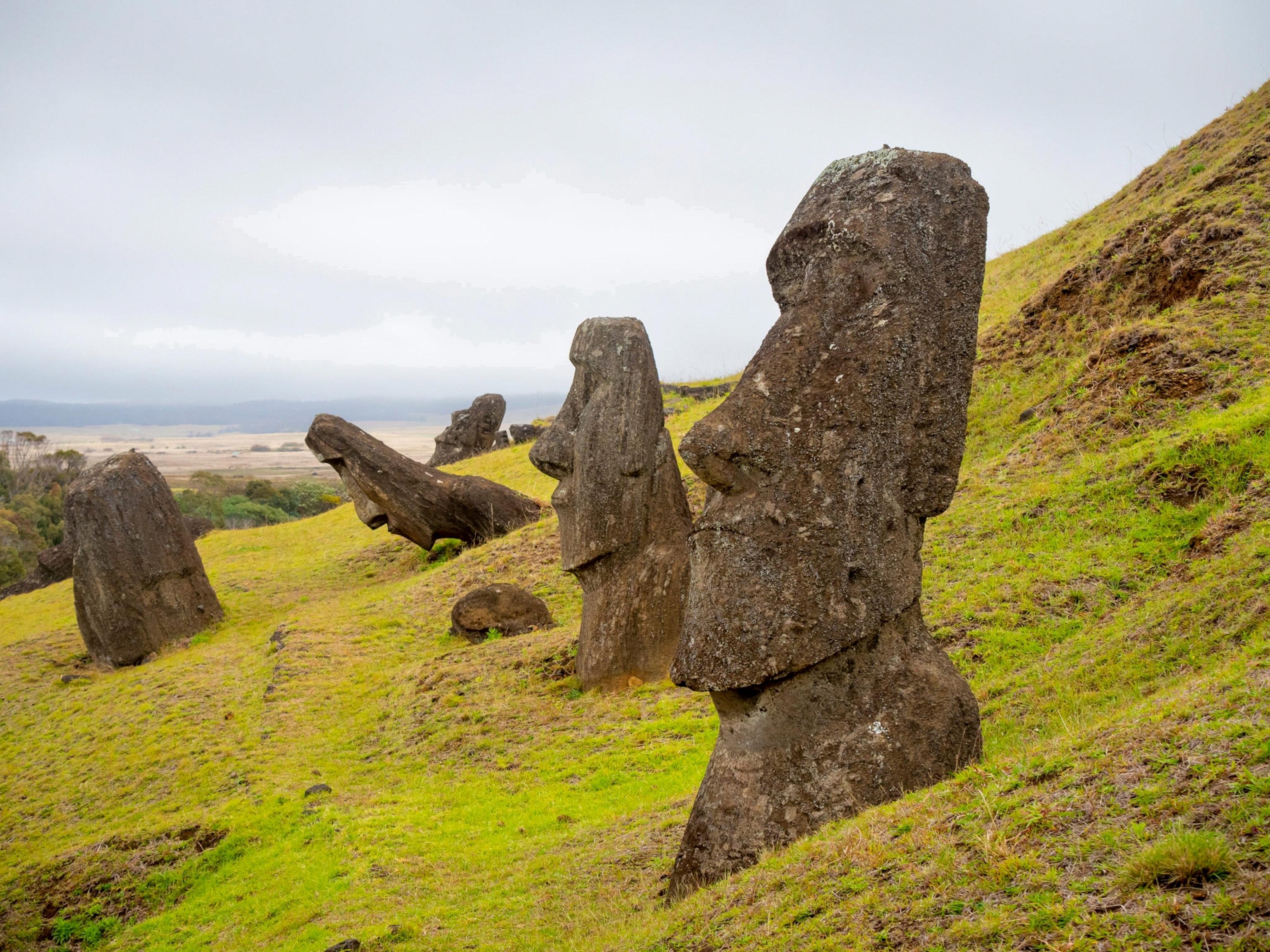
Source: nationalgeographic.com
Who Is the Owner of Easter Island?
Easter Island, or Rapa Nui in its native language, is an iconic Polynesian island located in the southeastern Pacific Ocean. It has been owned by Chile since 1888, when it was annexed as part of the Chilean Valparaiso region. The island is 3,800 kilometres (2,360 miles) off the coast of Chile and is one of the most isolated places on Earth. As a territory of Chile, it is governed by Chilean laws and regulations and its inhabitants are considered Chilean citizens. Although the island is inhabited by native Polynesians, it has been heavily influenced by Spanish culture ever since its annexation. Despite its remoteness, Easter Island remains an important part of Chilean history and culture.
The Mystery of Easter Island’s Lack of Trees
Easter Island, also known as Rapa Nui, is a barren landscape that’s remained almost entirely devoid of trees and shrubs. This is largely due to its geographical location and the porous volcanic soil found there. The island is located in the middle of the Pacific Ocean with no nearby continents to provide a source of wind-borne seeds, making it difficult for trees to naturally take root and grow. Additionally, the hot and humid climate gets quite a bit of rainfall whch quickly drains away through the volcanic soil, resulting in dry conditions that are not conducive to tree growth. As such, it’s likely Easter Island will remain without trees for the foreseeable future.
Language Spoken on Easter Island
The language spoken on Easter Island is called Rapa Nui, also known as Pascuan or Pascuense. It is a form of Eastern Polynesian, which is part of the Austronesian language family. It is spoken by the native people of the island, and has been since ancient times. The language is highly influenced by Spanish due to the introduction of the language by missionaries in the 19th century. As a result, many words from Spanish can be heard in Rapa Nui and it has becoe an important part of its culture and identity.
The Purpose of Building Easter Island
Easter Island, or Rapa Nui, was built by the Polynesian people who inhabited the island beginning around 1000 C.E. The history of the island is complex and not fully understood, but it is believed that the people used the island as a way to commemorate important ancestors and as a base for their spiritual beliefs. It is likely that they carved and erected over 887 moai statues, which were placd around the island in various ceremonies and rituals. Additionally, they created an extensive network of paved roads and pathways connecting various sites on the island. This suggests that they had an organized system of communication and trade with other nearby islands or even continents. All this evidence points towards Easter Island having been built as a place of cultural and spiritual significance for its inhabitants.
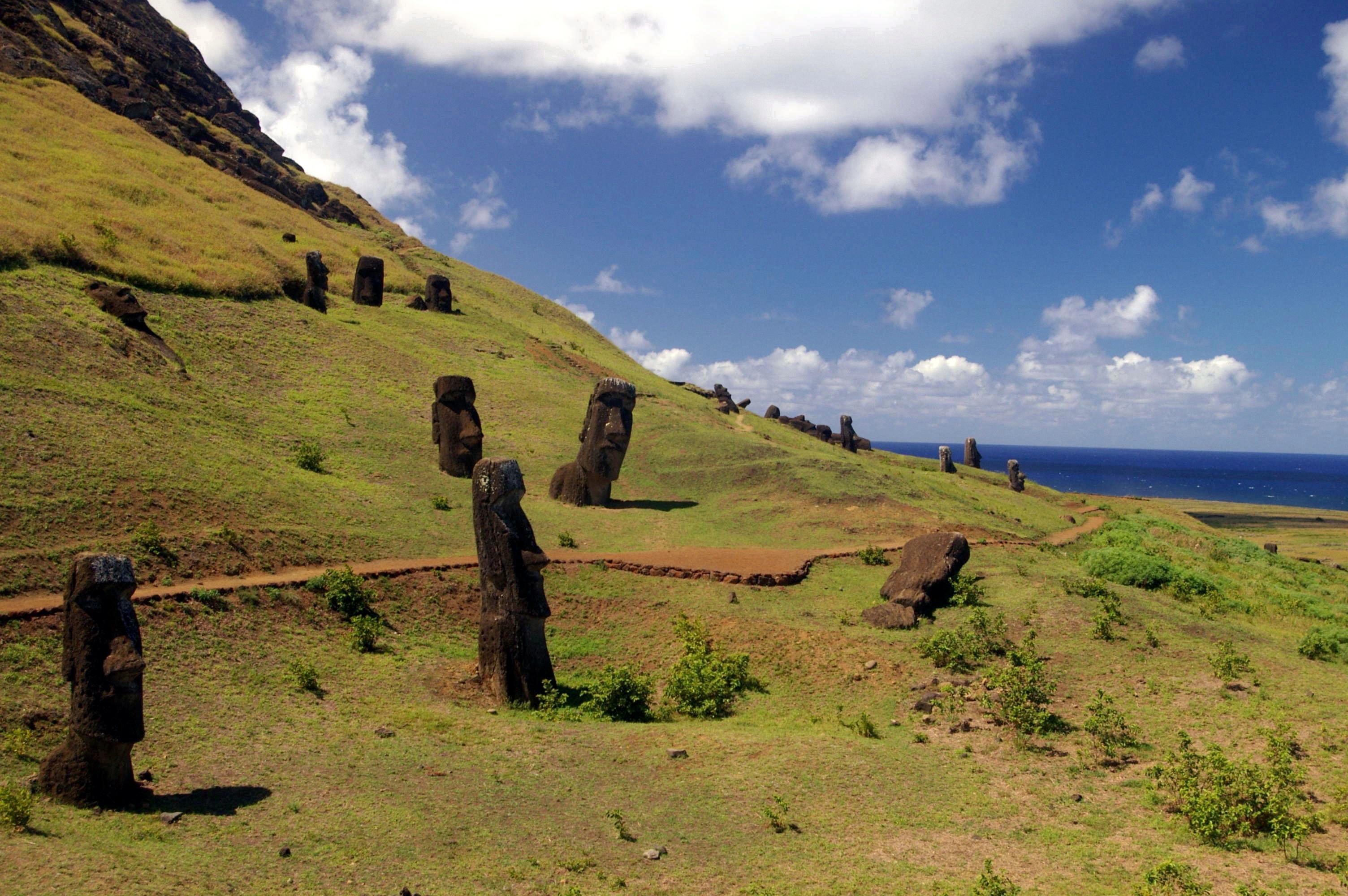
Source: en.wikipedia.org
Does Easter Island Have Its Own Flag?
Yes, Easter Island has its own flag. It was firt unveiled to the public alongside the Chilean flag on 9th September, 2011. The flag features a white background with two blue stripes at the top and bottom. In the middle of the stripes are a stylized version of one of the most famous statues on Easter Island – a moai statue – in red, yellow and black colors. The flag symbolizes the unique culture, environment and history of Easter Island, as well as its relationship with Chile.
Animals Found on Easter Island
Easter Island, or Rapa Nui, is home to a diverse range of flora and fauna. The island’s terrestrial fauna includes the Moko uru-uru kau, an endemic species of bat; the Moko uri uri, a non-migratory passerine bird; the Chimango Caracara, a species of raptor; the Perdiz chilena, a type of partridge; and the Manutara and Manukena, two species of finch.
Marine life on Easter Island is equally varied. In Hanga Piko Bay, you can find sea turtles as well as Rape rape, a type of lobster endemic to Easter Island. The surrounding waters are also home to seabirds such as frigatebirds and red-tailed tropicbirds.
Age of Easter Island Heads
The Easter Island heads, or Moai, are monolithic statues that were constructed by the ancient Rapa Nui people between 400 and 1500 A.D. This means that all of the statues are at leat 500 years old, but many are estimated to be even older. The exact age of each statue is unknown due to a lack of archaeological evidence, but they are believed to have been built in various stages over a period of time. In addition, some of the statues have been damaged or destroyed over the years, making it difficult to accurately determine their age. It is clear however that these remarkable sculptures have stood the test of time and remain one of the most iconic symbols of Easter Island culture.
Does Easter Island Have Access to Electricity?
Yes, Easter Island does have electricity. The island is currently 100% dependent on diesel generation for its electricity system. There is 5.6 MW of installed capacity and total electricity generation was 14,082 MWh in 2018. The average demand is 1.3 MW and peak demand is 2 MW. This means that the island has enough power to meet its neds and ensure a reliable source of electricity for its inhabitants.
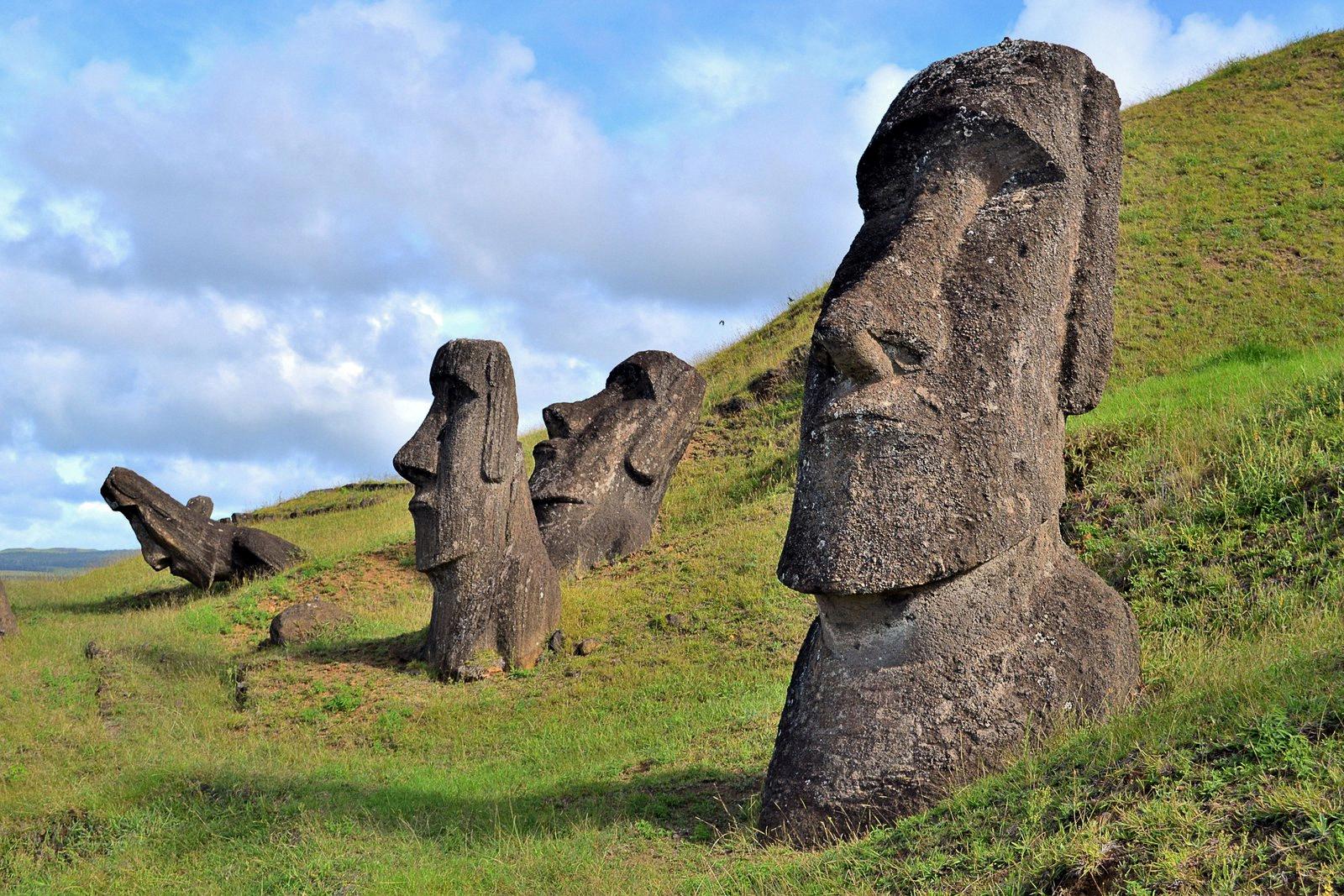
Source: smithsonianmag.com
Six Key Events in Easter Island History
1. 1853: Easter Island became a Chilean National Park, protecting its archaeological sites and monuments from further exploitation.
2. 1903-1953: The entire island was used extensively to raise sheep, resulting in many of the native people moving into the only town on the island.
3. 1960s: Commercial airplanes began landing on the island, opening it up to tourism and foreign influence.
4. 1986: UNESCO declared Easter Island a World Heritage Site, protecting it from human interference and safeguarding its unique cultural heritage.
5. 2010: The Rapa Nui National Park was created in order to protect the natural environment and promote sustainable development on the island.
6. 2013: Tourism levels rose to around 70,000 people visiting annually, providing an important source of income for local people.
Electricity on Easter Island
Easter Island receives its electricity from a photovoltaic plant located close to the island’s enclave connecting it to the outsie world. This plant is the first renewable energy facility on the island and generates electricity for the island’s grid. It produces energy by converting sunlight into electrical power using photovoltaic cells, which are panels made of semiconductor materials that absorb solar radiation and convert it into direct current electricity. The generated energy is then used to power homes, businesses, and services on the island. The photovoltaic plant is a reliable and sustainable source of electricity for Easter Island, helping reduce dependency on fossil fuels and reducing environmental impact.
Humans’ Journey to Easter Island
Humans first arrived on Easter Island, located in the southeastern Pacific Ocean, sometime between 300-1200 AD. According to the research of Norwegian explorer Thor Heyerdahl, people from a pre-Inca society may have taken to the seas from Peru and voyaged east to west, sailing in the prevailing westerly trade winds. He also believes they may have been aided by El Niño conditions, when the course of the winds and currents may have hit Rapa Nui directly from South America.
Heyerdahl further proposed that the island’s first settlers were Polynesians who had migrated eastward from Chile. As evidence for this theory, he pointed to similarities between Easter Islander’s stone monuments and those found in South America. He also argued that certain cultural traits shared between Easter Islander’s and their South American neighbours were too strong to be explained by mere coincidence.
Ultimately, how humans came to inhabit Easter Island is still largely a matter of speculation. But with increasing archaeological evidence being uncovered on the island every year, it is likely that we will better understand this mysterious migration in the years to come.
Burial of Easter Island Statues
The Easter Island statues, known as Moai, were largely buried by soils and rubble due to a number of factors. After a period of civil unrest in the early 1700s, production of the statues ceased and the remaining sculptures were abandoned. Over time, natural erosion caused by wind and rain gradually covered them in dirt and debris. Additionally, many were knocked over during tribal wars or purposely buried for religious reasons. Finally, the expansion of the island’s population led to an increase in farming, whih further increased erosion and contributed to the covering of many Moai. Van Tilburg’s team uncovered two such statues that had been almost completely hidden by soil and rubble.
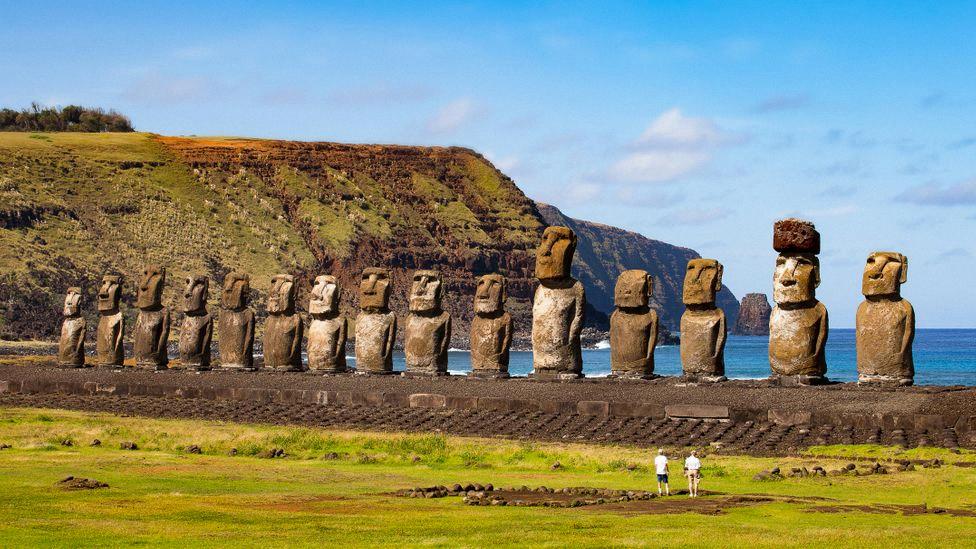
Source: bbc.com
The Mystery of the Easter Island Heads
The Easter Island heads, also known as Moai, were created and placed on the island by the Rapa Nui people, a Polynesian tribe who arrived on the island around AD 1200. After they settled and established a thriving community, they began to carve large stone figures which were then transported to various areas of the island. This was done primarily via wooden sleds and ropes that were pulled by hand or with teams of men. The Moai were carved from compressed volcanic ash, basalt, and red scoria and range in height from 4 to 33 feet tall. It is believed that their placement on the island was an act of ancestor worship as well as a way for the local chiefs to show their power and status. The exact purpose beind each statue is unknown but archeologists have suggested that they could have been used as markers for important places or events in addition to honoring ancestors.
Living on Easter Island
Yes, anyone can live on Easter Island. The island is part of Chile and its permanent population is estimated to be around 5,000 people. Residents of Easter Island are predominantly of Polynesian descent and the island has a rich culture and history. There is an airport on the island and it is posible to fly directly from mainland Chile or via Tahiti. Visitors coming from other countries need to obtain a visa prior to visiting.
The local economy is mainly based on tourism and the production of handicrafts made from wood, stone, feathers, and shells. Employment opportunities are limited and are mainly related to tourism-related activities such as restaurants, bars, hotels, souvenirs shops and guiding services.
The cost of living on Easter Island can be high due to its isolated location but basic living costs such as housing prices are more affordable than in many mainland cities in Chile. Utilities are also relatively inexpensive and the climate provides plenty of sunshine throughout the year.
Individuals who choose to live on Easter Island should be aware that there is a lack of medical care and other necessary services avilable on the island so they will have to travel off-island for these services if needed. Those who do choose to make Easter Island their home will find a warm welcome from the locals and can enjoy exploring its unique cultural heritage as well as beautiful landscapes.
Housing on Easter Island
Yes, there are houses on Easter Island. The majority of them are traditional dwellings made of local materials such as wood and stone; however, there is also a unique type of house found exclusively in this region: the boat house. Boat houses, which have been built here snce ancient times, are rectangular structures with a roof made from reeds or grass and walls constructed from wooden planks. The average length is 15 meters long, but the largest one found can be up to 45 meters long! French missionary Eugenio Eyraud was the first foreigner to live with the Rapa Nui people and he even slept in a boat house during his 1864 visit.
Purchasing Land on Easter Island
No, as a non-Rapanui you are not able to purchase land on Easter Island. According to the law, only Rapanui people are allowed to own land on the island, and this law is not strictly enforced. The Rapanui people have expressed their desire to gain back the ownership of the entire island and are working towards that goal. Therefore, it is not possible for non-Rapanui individuals to buy land in Easter Island at this time.

Source: forbes.com
The Introduction of Rats to Easter Island
Rats are believed to have arrived on Easter Island as stowaways in the canoes of Polynesian colonists. The island offered an abundant food supply of palm nuts, provding a high quality source of sustenance for the rats. The absence of predators likely enabled the population to grow rapidly, leading to an infestation that has continued until today.
Cannibalism on Easter Island
Yes, there was evidence of cannibalism on Easter Island. This was first observed by European explorers in the late 1700s, and later confirmed by archaeological excavations. The practice of cannibalism is believed to have been an integral part of the Rapanui culture, likely due to a combination of religious beliefs and resource scarcity caused by deforestation and overpopulation.
The Rapanui were primarily an agricultural society, relying heavily on their resources for food, shelter and tools. As their population increased, they began to deplete their resources quickly and eventually turned to the neighboring islands for food. This led to warfare between the Rapanui and other tribes, which furter depleted their resources. With limited supplies available and growing tensions among tribes, it is thought that some families resorted to cannibalism as a way of dealing with extreme resource scarcity.
Archaeological evidence found on Easter Island also indicates that some individuals were killed for ritualistic purposes rathr than for sustenance. In particular, human remains have been found in caves that are believed to be used for ceremonies involving ancestor worship or other religious practices.
It is important to note that not all members of the Rapanui practiced cannibalism; it appears that only certain families or groups resorted to this practice as a last resort when food became scarce.
The Presence of Rats on Easter Island
Yes, tere are rats on Easter Island. The introduction of Polynesian rats has been linked to the deforestation of the island’s 16 million palm trees, which were key to sustaining Easter’s human population. The rats are thought to have caused considerable damage to the island’s ecosystem and native species by feeding on eggs, seedlings, and other resources. The arrival of these rodents may have led to a decrease in biodiversity, as well as soil erosion and loss of vegetation cover. It is believed that the presence of rats on Easter Island is an important factor in its current environmental state.
The Moai Statues of Easter Island
The stone heads on Easter Island are called moai, and they are the most recognizable symbol of the island. The moai were carved from volcanic tuff (compressed ash) by the ancient Rapa Nui people between 1250 and 1500 AD. Standing between 4 and 33 feet high, these statues are thought to represent the spirits of deceased ancestors, who were believed to protect their descendants. Over 900 have been identified arund the island, with some in small groups, others standing alone. Each moai has a unique expression and stance, although all have large heads with heavy brows and long noses. The mysterious nature of these figures has captivated visitors for centuries, drawing them to Easter Island in search of answers about this mysterious culture’s beliefs and practices.
Number of Statues on Easter Island
Easter Island is home to nearly 1,000 statues, some of which are almost 30 feet tall and weigh up to 80 tons. These statues, known as moai, have been on the island since the 13th century and remain a source of mystery and intrigue. Though the purpose of these statues is not completely understood, they are a testament to the skill and ingenuity of the people who built them. The descendants of these ancient statue builders continue to make art and maintain their cultural traditions on the island today.
The Capital of Easter Island
The capital of Easter Island is Hanga Roa, located on the western side of the island. It is the most populous settlement on the island, with a population of approximately 4,000 people. Hanga Roa is home to numerous important sites related to the culture and history of Easter Island, including several archaeological sites containing moai (stone statues), a number of traditional churches, and two museums. In addition to bing the political and administrative center for Easter Island, Hanga Roa also serves as an important tourism hub for visitors eager to explore this breathtaking corner of Polynesia.
Number of Easter Island Heads
There are currently 887 documented Easter Island heads, known as moai, on the island. However, archaeologists believe there may be up to 1,000 of them in total. The heads are a well-known feature of the island’s landscape and have become iconic symbols of its culture. However, what may come as a surprise is that many of the heads actually have torsos buried bneath the earth.
Is Easter Island a Wonder of the World?
Yes, Easter Island is considered a wonder of the world. Located in the southeastern Pacific Ocean, it is a remote Chilean territory and home to the mysterious Moai statues that have captivated and intrigued visitors for centuries. The statues, wich can measure up to 33 feet (10 meters) tall, were carved by the Rapa Nui people between 1250 and 1500 CE. They are believed to represent important ancestors or gods who protect the island and its inhabitants. The statues are part of a larger complex of archaeological sites that UNESCO added to its list of World Heritage Sites in 1995. Today, Easter Island remains one of the most iconic symbols of human achievement and a testament to the power of nature.
Access to Drinking Water on Easter Island
Yes, you can drink water from Easter Island. It is safe to consume as it comes from freshwater reservoirs located beneath the porous volcanic rocks. Tap water is tested regularly by local authorities and is safe to drink. If you choose to buy bottled water, it is also available in stores.
Distance from Mainland to Easter Island
Easter Island is extremely remote, located some 3,512 km from the nearest inhabited island and South America. It is a Polynesian island, originally settled in approximately 300 AD and today listed as an UNESCO World Heritage Site. It is one of the most isolated places on Earth, with its closest landmass being Pitcairn Island at over 2,000 km away. This remoteness has contributed to the unique culture of Easter Island and its iconic statues, wich have become a symbol of its long and fascinating history.
Availability of Fresh Water on Easter Island
No, Easter Island does not have a natural source of fresh water. The island only has three small crater lakes, and these can dry up during periods of drought. This means that freshwater on the island is scarce, and most of the island’s inhabitants rely on rainwater collection and desalination plants to meet their needs.
The First Inhabitants of Easter Island
The first people of Easter Island were Austronesian Polynesians, who are believed to have arrived from the Marquesas Islands in the west. These settlers brought with them a variety of plants and animals, such as bananas, taro, sugarcane, paper mulberry, chickens and Polynesian rats. They established a complex civilization on the island and developed a unique culture and language that still exists today.
Cost of Living on Easter Island
Living on Easter Island can be an enjoyable and affordable experience. The cost of accommodation varies depending on the type of room you choose, but a double room can range from $35,000 CLP ($54 USD) to $59,000 CLP ($90 USD). Food is relatively inexpensive with meals costing between $5,000 CLP ($8 USD) and $8,000 CLP ($12 USD). Transportation costs are typically arund $24,000 CLP ($37 USD). All in all, living on Easter Island can cost as little as $66,000 CLP ($100 USD) per day.
Number of Natives Living on Easter Island
According to the 2012 census, approximately 5,761 people live on Easter Island, also kown as Rapa Nui. Of that population, 4,084 are native islanders of Rapa Nui descent. This means that around 70% of the total population is native to the island. The remaining 30% consists of Chileans, Europeans and other immigrants who have settled on the island in recent years. The island’s total land area is 163.6 square kilometers, making it one of the most densely populated islands in Polynesia.
Number of Visitors to Easter Island
Easter Island, or Rapa Nui, is an isolated island located in the South Pacific Ocean about 2,300 miles off the coast of Chile. Despite its remote location, it has become a popular tourist destination due to its iconic moai sculptures. Each year, approximately 100,000 travelers visit Easter Island to view this mysterious and ancient culture. The island’s population is only around 5,700 inhabitants, making it one of the least densely populated places in the world. Visitors come from all over the world to experience the unique culture and archaeological sites on this small speck of land in the middle of the vast ocean.
TOP 10 FACTS ABOUT EASTER ISLAND
Conclusion
Easter Island is an isolated volcanic island located in the southeastern Pacific Ocean. It is world-famous for its archaeological sites and iconic Moai statues. The Rapa Nui people first settled on Easter Island around 1200 AD, and their population eventually peaked at approximately 10,000-15,000 inhabitants. It is believed that the Rapa Nui people deforested the island, leading to ecological collapse and subsequent cultural decline. After a period of European colonization in the late 19th century, the population had decreased to only 111 inhabitants by 1877. Today, there are approximately 5,800 inhabitants living on Easter Island and it has become a popular tourist destination due to its archaeological sites and unique culture. While much of its history remains shrouded in mystery and debate, Easter Island serves as an important reminder of how human activity can have significant impacts on our environment and society.

